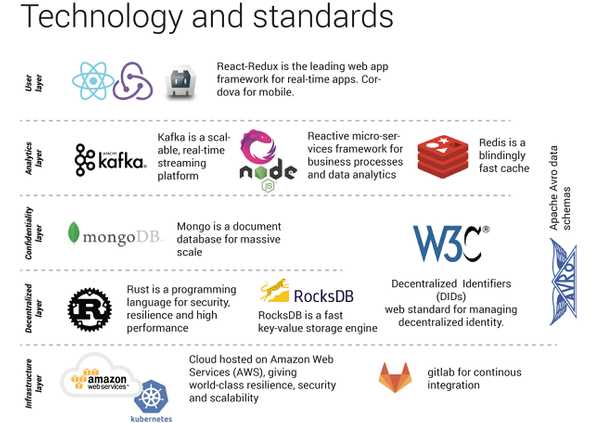IOUze - Blockchain for real businesses
January 16, 2019 • ☕️ 6 min read
Can we re-imagine how blockchains can transform business? There are few, if any, credible uses of blockchains in mainstream use. But, stepping back from the hype around some of the initial experiments, the excitement around blockchain emerged from a very real yearning for a transformed internet that offers:
(1) Real control over our own digital transactions and data; (2) which enables social and business interactions that are direct and friction-less; and (3) that allow us to participate with complete trust in open communities that evolve and grow in interesting ways previously not imagined.
Inspired by this vision and reflecting on typical human experiences in managing businesses, it is clear that despite the massive introduction of technology, managing business transactions still consumes an enormous amount of human energy. We have become numb to how much friction there is in mundane business processes: ordering, quoting, delivering, receiving, invoicing, paying, etc. This further explodes when we also consider the duplicated effort of multiple participants in this transaction life-cycle: buyer, seller, supplier, logistics provider, banks, tax authority, accountants, etc.
This may sound like a problem that ERP systems solve, but ERP systems are painfully expensive, difficult to run and actually perpetuate these inefficiencies. At IOUze, we have a passion to help small businesses flourish [4] with access to data to manage their business transactions on a decentralised supply chain platform. Not only does this simplify operations, but it becomes a foundation for access to financing.
We believe that we can make giant strides in removing friction from business by starting with two practical goals: (1) to be able to trust that each counterpart with whom we interact is who they claim to be (2) to be able to trust the integrity of the transactional data that we use and to reliably know that it is the same as that used by the other counterparts in each transaction. Through sharing of data, we efficiently distribute and share the work needed to manage the transaction.
This implies sound privacy, tamper-evident data, audit-ability, scalability and responsiveness (characteristics that are often challenging for existing blockchain solutions).
In addition such a platform must be open [6], extensible and simple to adopt.
A tall order, but is there a way to bootstrap these goals?
An open network for business
A network of shared, confidential data
To support the rich diversity of business transactions, we introduce data models that are simple, extensible and adaptable to different business domains. Some basic standardisation is essential, but as little as necessary should be centralised.
Data is shared with little friction, so that there is always “one real-time version of the truth” for all participants in each transaction, with strong privacy protection.
We draw on the work done by the W3C on Linked Data [1] (with a strong belief in its ‘open world’ philosophy) and DID standards [2]. And we add cryptographic techniques that achieve the trust and privacy goals.
A network of agreements
Rather than relying on ‘closed’ smart contracts we build on a simple model of ‘attestations’ or ‘signatures’ that are performed by the various participants in a transaction. These ‘attestations’ define the real-time events of a transaction: quotes being accepted, goods dispatched, goods received, goods returned, payments made, payments received. While we can’t fully guarantee trustworthiness and completeness, the improvement over the status quo is radical.
This is flexible enough to deal with the imperfections of the real world, while creating a trustworthy foundation for automation.
A network of reliable identity
A key requirement to make this achievable is that we reliably know ‘who is who’ on the network. We embrace the W3C’s Decentralised Identity (DID) model [2]. Our network provides decentralised identity services and can connect seamlessly to other DID providers.
Design
The IOUze network is designed with four layers:
A “trust layer” ensures that data is immutable; that identity is reliable; that signatures (attestations) can be trusted; and that privacy and audit-ability are preserved (using zero knowledge proofs [5]). This layer is a true decentralised blockchain. Only fully public data is stored on this layer.
A “confidentiality layer” manages the confidential data of business transactions. Participants can host their own encrypted confidential data or select ‘agents’ that they trust. Agents have no access to the data, except in encrypted form. They control access to this encrypted data, along with encrypted keys that allow for controlled sharing. We can consider this layer as “somewhat” decentralised, and there is a soft element of trust in the agent.
These first two layers implement a proposed open protocol.
An “analytics layer” that manages business processes and analytics. This layer is mostly proprietary, allowing each participant to easily tailor solutions to their needs. The analytics layer offers rich opportunities for affordable reusable solutions within specific business sectors.
A “user layer” that provides the user interface to the network. The other layers create a foundation that makes it easy to build disruptive applications with exceptional user experience.
A vision based on simplicity
This model of sharing transactional data leads to a distributed ERP-like / working capital management solution that is simple enough to use on a mobile phone, with little or no implementation effort for the end user. It greatly simplifies transactions because counterparts do a significant portion of the work for each other (capturing and attesting to business events). This radically transforms how small businesses interact, share services and ultimately form valuable digital communities. The open platform can evolve in exciting ways, in much the same way as the internet evolved unforeseen new digital communities from a very simple information sharing model.
Great technology is critical to our ability to move fast, but the real differentiating focus is a product design that supports adoption in real businesses.
Where we stand
The network is currently in pilot.
The first use case is a business lending platform that matches small businesses with investors and gives businesses access to loans at a reasonable rate. Unlike other similar use cases, it ties the lending into an operational capability to manage supply chain transactions so that risk is greatly reduced for both borrowers and lenders.
The second use case manages distribution in the construction industry. Construction supply chains are among the most complex and this pilot is a strong validation of the IOUze approach.
We are reaching out to like-minded potential partners that share a dream of taking friction out of doing business and promoting more agile business networks, with a bias to supporting small businesses. If you have an interest, please contact us on: hello@iouze.com
[1] https://www.w3.org/wiki/LinkedData
[2] https://w3c-ccg.github.io/did-spec/
[3] https://en.wikipedia.org/wiki/TheDAO(organization)
[5] https://en.m.wikipedia.org/wiki/Zero-knowledge_proof
[6] http://www.hbs.edu/faculty/Publication%20Files/09-030.pdf
An aside: What is wrong with smart contracts?
The first generation of blockchain ‘smart contracts’, has three drawbacks. Firstly, they are very rigid with little capability to deal with exceptions that have not been foreseen by the author. They are underpinned by a naive belief that computer code can fully express the meaning of a contract, and that this meaning is fixed and final. This has been proven wrong in spectacular ways [3]. Secondly, smart contracts struggle to deal with events that happen off the blockchain (which are inevitable in almost any real world use case). Complex ‘oracle’ mechanisms are introduced to deal with this, but they are difficult to adopt. Thirdly, smart contracts are difficult to scale and have very simplistic ways to interact, so they ultimately create ‘walled gardens’ [6].

